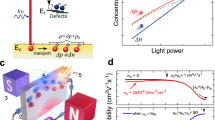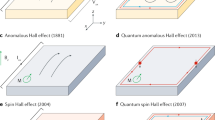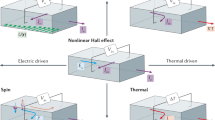Abstract
The fundamental parameters of majority and minority charge carriers—including their type, density and mobility—govern the performance of semiconductor devices yet can be difficult to measure. Although the Hall measurement technique is currently the standard for extracting the properties of majority carriers, those of minority carriers have typically only been accessible through the application of separate techniques. Here we demonstrate an extension to the classic Hall measurement—a carrier-resolved photo-Hall technique—that enables us to simultaneously obtain the mobility and concentration of both majority and minority carriers, as well as the recombination lifetime, diffusion length and recombination coefficient. This is enabled by advances in a.c.-field Hall measurement using a rotating parallel dipole line system and an equation, ΔμH = d(σ2H)/dσ, which relates the hole–electron Hall mobility difference (ΔμH), the conductivity (σ) and the Hall coefficient (H). We apply this technique to various solar absorbers—including high-performance lead-iodide-based perovskites—and demonstrate simultaneous access to majority and minority carrier parameters and map the results against varying light intensities. This information, which is buried within the photo-Hall measurement1,2, had remained inaccessible since the original discovery of the Hall effect in 18793. The simultaneous measurement of majority and minority carriers should have broad applications, including in photovoltaics and other optoelectronic devices.
This is a preview of subscription content, access via your institution
Access options
Access Nature and 54 other Nature Portfolio journals
Get Nature+, our best-value online-access subscription
$29.99 / 30 days
cancel any time
Subscribe to this journal
Receive 51 print issues and online access
$199.00 per year
only $3.90 per issue
Buy this article
- Purchase on Springer Link
- Instant access to full article PDF
Prices may be subject to local taxes which are calculated during checkout



Similar content being viewed by others
Data availability
The datasets generated and analysed during the current study are available from the corresponding author on reasonable request.
References
Fowler, A. Photo-Hall effect in CdSe sintered photoconductors. J. Phys. Chem. Solids 22, 181–188 (1961).
Dresner, J. The photo-Hall effect in vitreous selenium. J. Phys. Chem. Solids 25, 505–511 (1964).
Hall, E. H. On a new action of the magnet on electric currents. Am. J. Math. 2, 287–292 (1879).
Klitzing, K. v., Dorda, G. & Pepper, M. New method for high-accuracy determination of the fine-structure constant based on quantized Hall resistance. Phys. Rev. Lett. 45, 494–497 (1980).
Tsui, D. C., Stormer, H. L. & Gossard, A. C. Two-dimensional magnetotransport in the extreme quantum limit. Phys. Rev. Lett. 48, 1559–1562 (1982).
Ponseca, C. S., Jr et al. Organometal halide perovskite solar cell materials rationalized: ultrafast charge generation, high and microsecond-long balanced mobilities, and slow recombination. J. Am. Chem. Soc. 136, 5189–5192 (2014).
Leijtens, T. et al. Electronic properties of meso-superstructured and planar organometal halide perovskite films: charge trapping, photodoping, and carrier mobility. ACS Nano 8, 7147–7155 (2014).
Xing, G. et al. Long-range balanced electron-and hole-transport lengths in organic-inorganic CH3NH3PbI3. Science 342, 344–347 (2013).
Stranks, S. D. et al. Electron–hole diffusion lengths exceeding 1 micrometer in an organometal trihalide perovskite absorber. Science 342, 341–344 (2013).
Wehrenfennig, C., Liu, M., Snaith, H. J., Johnston, M. B. & Herz, L. M. Charge-carrier dynamics in vapour-deposited films of the organolead halide perovskite CH3NH3PbI3−xClx. Energy Environ. Sci. 7, 2269–2275 (2014).
Shi, D. et al. Low trap-state density and long carrier diffusion in organolead trihalide perovskite single crystals. Science 347, 519–522 (2015).
Dong, Q. et al. Electron–hole diffusion lengths >175 μm in solution-grown CH3NH3PbI3 single crystals. Science 347, 967–970 (2015).
Chen, Y. et al. Extended carrier lifetimes and diffusion in hybrid perovskites revealed by Hall effect and photoconductivity measurements. Nat. Commun. 7, 12253 (2016).
Gokmen, T., Gunawan, O. & Mitzi, D. B. Minority carrier diffusion length extraction in Cu2ZnSn(Se,S)4 solar cells. J. Appl. Phys. 114, 114511 (2013).
National Renewable Energy Laboratories. Best research-cell efficiencies https://www.nrel.gov/pv/cell-efficiency.html (2019).
Tan, Z.-K. et al. Bright light-emitting diodes based on organometal halide perovskite. Nat. Nanotech. 9, 687–692 (2014).
Dou, L. et al. Solution-processed hybrid perovskite photodetectors with high detectivity. Nat. Commun. 5, 5404 (2014).
Gunawan, O., Virgus, Y. & Tai, K. F. A parallel dipole line system. Appl. Phys. Lett. 106, 062407 (2015).
Sze, S. M. & Ng, K. K. Physics of Semiconductor Devices 3rd edn (John Wiley & Sons, 2006).
Schroder, D. K. Semiconductor Material and Device Characterization 3rd edn (John Wiley & Sons, 2006).
Gunawan, O. & Gokmen, T. Hall measurement system with rotary magnet. US patent 9,041,389 (2015).
Gunawan, O. & Pereira, M. Rotating magnetic field Hall measurement system. US patent 9,772,385 (2017).
Gunawan, O. & Virgus, Y. The one-dimensional camelback potential in the parallel dipole line trap: Stability conditions and finite size effect. J. Appl. Phys. 121, 133902 (2017).
Jeon, N. J. et al. Compositional engineering of perovskite materials for high-performance solar cells. Nature 517, 476–480 (2015).
Zhang, C. et al. Magnetic field effects in hybrid perovskite devices. Nat. Phys. 11, 427–434 (2015).
Levine, I. et al. Can we use time-resolved measurements to get steady-state transport data for halide perovskites? J. Appl. Phys. 124, 103103 (2018).
Wehrenfennig, C., Eperon, G. E., Johnston, M. B., Snaith, H. J. & Herz, L. M. High charge carrier mobilities and lifetimes in organolead trihalide perovskites. Adv. Mater. 26, 1584–1589 (2014).
Sum, T. C. et al. Spectral features and charge dynamics of lead halide perovskites: origins and interpretations. Acc. Chem. Res. 49, 294–302 (2016).
Rosling, M., Bleichner, H., Jonsson, P. & Nordlander, E. The ambipolar diffusion coefficient in silicon: dependence on excess-carrier concentration and temperature. J. Appl. Phys. 76, 2855–2859 (1994).
Sinton, R. A. & Cuevas, A. Contactless determination of current–voltage characteristics and minority carrier lifetimes in semiconductors from quasi steady state photoconductance data. Appl. Phys. Lett. 69, 2510–2512 (1996).
Acknowledgements
S.R.P. and B.S. acknowledge financial support from the Technology Development Program to Solve Climate Changes of the National Research Foundation (NRF) funded by the Ministry of Science, ICT & Future Planning (no. 2016M1A2A2936757), and from the Korea Institute of Energy Technology Evaluation and Planning (KETEP) and the Ministry of Trade, Industry & Energy (MOTIE) of the Republic of Korea (no. 20173010012980). J.H.N. acknowledges financial support from NRF grants funded by the Korea government (MSIP) (2017R1A2B2009676, 2017R1A4A1015022). D.B.M. and O.G. thank the National Science Foundation for support under grant no. DMR-1709294. We thank S. Guha for managing the IBM photovoltaics program; H. Hamann for support; M. Pereira and K. F. Tai for PDL Hall system development; B. Hekmatshoartabari for the silicon sample; and J. Kim for Supplementary Table 4.
Author information
Authors and Affiliations
Contributions
O.G. and B.S. conceived the project. O.G. led the project, built the experimental setup, programmed the analysis software, derived equation (1) and other formulas, and performed measurement and analyses. S.R.P. prepared samples, and performed optical and Hall measurements and analysis. O.G., S.R.P., B.S. and D.M.B. developed data analysis, interpretation and participated in manuscript writing. Y.V. helped with the development of the PDL system and derivation of the formulae. Y.S.L. and D.M.B. helped with the optical study. N.J.J. and J.H.N. prepared the perovskite samples and solar cells. D.B.M., T.T. and X.S. developed the champion CZTSSe process. D.B.M. managed the IBM photovoltaics program and participated in manuscript writing.
Corresponding authors
Ethics declarations
Competing interests
The PDL Hall system was developed at IBM Research and documented in the following patent families: (1) O. Gunawan & T. Gokmen, US 9,041,389 (ref. 21); (2) O. Gunawan & M. Pereira, US 9,772,385 (ref. 22), US 9,678,040, US 15/581183 and related patent applications (WO 2016162772A1, UK 1717263.6, Japan 2017-552496, Germany 112016000875.9); (3) O. Gunawan, US 15/281,968; (4) O. Gunawan & W. Zhou, US 16/382,937. Patent families (1) and (2) cover the basic a.c. field/PDL Hall system, and (3) and (4) cover the related photo-Hall setup and method.
Additional information
Publisher’s note Springer Nature remains neutral with regard to jurisdictional claims in published maps and institutional affiliations.
Peer review information Nature thanks Henry Snaith and the other, anonymous, reviewer(s) for their contribution to the peer review of this work.
Extended data figures and tables
Extended Data Fig. 1 Performance of the (FAPbI3)0.88(MAPbBr3)0.12 solar cell device.
a, Current density–voltage (J–V) curves measured by reverse (black) and forward (red) scans. The photovoltaic performance values are summarized in the table. b, The external quantum efficiency spectrum. c, Histogram of the power conversion efficiencies obtained from J–V curves measured by reverse scan (grey) and forward scan (blue), and the average for 80 cells (red).
Supplementary information
Supplementary Information
This file contains Supplementary Text, sections A–H; Supplementary Figures S1–S8; Supplementary Tables 1–4, Supplementary Equations 4–38; and Supplementary References 31–83.
Supplementary Video 1
| Animation of the rotating parallel dipole line (PDL) Hall system and its field evolution The master magnet generates a counterclockwise field rotation (red) while the slave magnet follows synchronously but in the opposite direction, generating a clockwise field rotation (green). This results in a total field (blue) that is unidirectional (always pointing normal to the sample) and single harmonic at the centre where the sample resides.
Rights and permissions
About this article
Cite this article
Gunawan, O., Pae, S.R., Bishop, D.M. et al. Carrier-resolved photo-Hall effect. Nature 575, 151–155 (2019). https://doi.org/10.1038/s41586-019-1632-2
Received:
Accepted:
Published:
Issue Date:
DOI: https://doi.org/10.1038/s41586-019-1632-2
This article is cited by
-
Resolving electron and hole transport properties in semiconductor materials by constant light-induced magneto transport
Nature Communications (2024)
-
Phenyltrimethylammonium as an Interlayer Spacer for Stable Formamidinium-Based Quasi-2D Perovskite Solar Cells
Electronic Materials Letters (2024)
-
Electron-phonon interactions in halide perovskites
NPG Asia Materials (2022)
-
Hall-Bulk photovoltaic effect in BiFeO3/SrTiO3 at low temperatures
Communications Physics (2022)
-
A room-temperature gate-tunable bipolar valley Hall effect in molybdenum disulfide/tungsten diselenide heterostructures
Nature Electronics (2021)
Comments
By submitting a comment you agree to abide by our Terms and Community Guidelines. If you find something abusive or that does not comply with our terms or guidelines please flag it as inappropriate.



